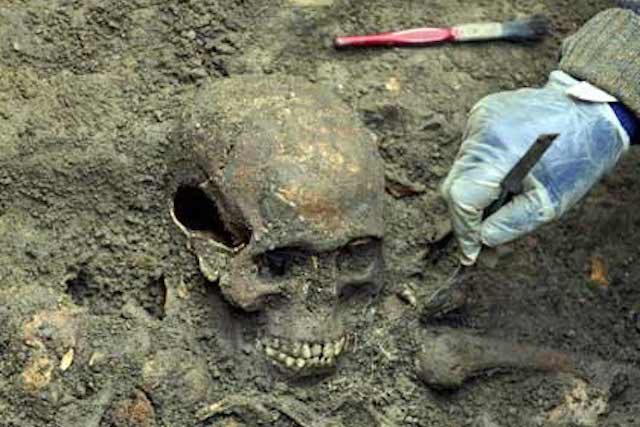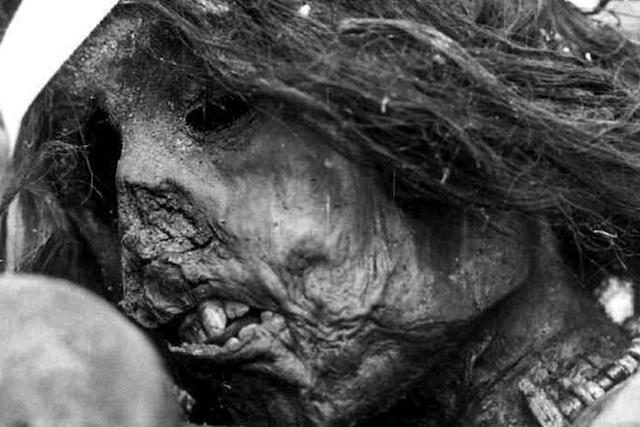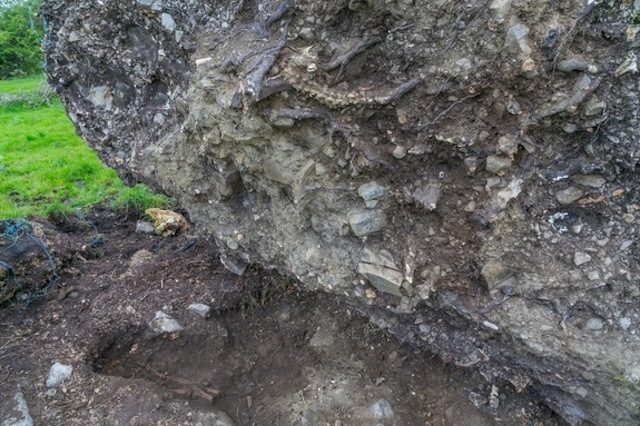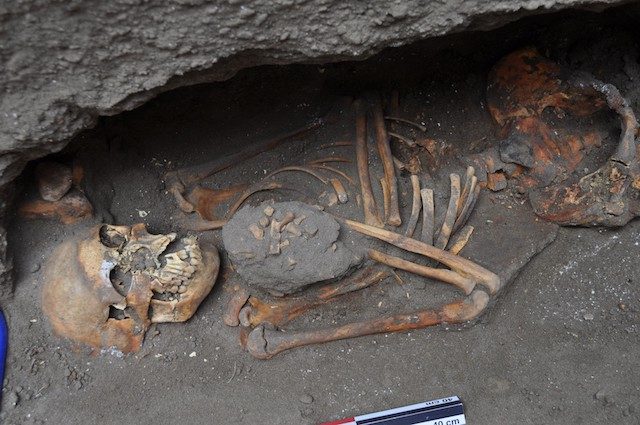With archaeology, we are able to take a peek into the past. Ancient texts, though revealing, often times are subjective, written by conquerors and victors, skewing the facts to make themselves appear in a more positive light. But ancient relics, buried deep in the ground by time or people, tell a more complete story of what happened hundreds, if not thousands of years ago.
With the help of archaeology, scientists and historians can slowly piece together the story of humanity and the planet itself. And as these things often are, long forgotten secrets can sometimes be scary, if not downright gruesome. Here are 10 such grim archaeological discoveries.
10. The First Recorded Boomerang Victim – Australia

Even though we tend to think of boomerangs as toys to be thrown around, they are in fact deadly weapons with which the Aboriginals have been hunting and killing for thousands of years. In 2014, in Australia’s Toorale National Park, on the banks of the Darling River, a skeleton belonging to an Aboriginal was discovered by a local man. Knowing it to belong to one of his ancestors, William Bates, an Aboriginal himself, named him Kaakutja – “older brother” in the Baakantji language. Taking a closer look, Mr. Bates noticed a gash over Kaakutja’s right eye, extending all the way to his jaw. It first appeared as if the skull was struck by an iron blade, with the skeleton belonging to one of the many victims of frontier violence from the time of British colonization of Australia.
However, on closer inspection by Michael Westaway, a paleoanthropologist at Griffith University in Queensland, Australia, it was discovered that this was not the case. In fact, Kaakutja lived some 500 years before the British ever set foot on the continent, and that the man was in his 20s or 30s when he died. Moreover, several other signs of trauma were discovered all over the skeleton, marks which were made by a wooden object, rather than a metal sword. Scientists were puzzled at first since no one had ever seen trauma such as this in Australia’s entire archaeological history. While several of the other wounds came from a Lil-lil, a wooden club made to look and perform like an ordinary axe, the gash on his face was clearly from a battle boomerang. When found, Kaakutja was lying on his right side in a tightly curled up position and with his mouth wide open. These all indicate a gruesome and violent death sometime between 1260 and 1280 AD.
9. The First Victims of War – Kenya

War was always believed to have appeared onto the world stage alongside agriculture and animal husbandry, when mankind renounced its hunter-gatherer lifestyle and opted for a more sedentary way of life. This is also the time when wealth and belongings beyond one’s immediate needs came into existence, and also when it became profitable for a person to own another. These, of course, don’t rule out the occasional individual murders among various families. They refer to actual wars between groups of hunter-gatherers without a strict social hierarchy system, which were believed to be virtually nonexistent. This notion, however, may have been turned on its head when a group of 27 skeletons were found on the edge of Lake Turkana, Kenya, in 2012.
Dating back to between 9,500 and 10,500 years ago, these 27 bodies of men, women, and children, all showed signs of blunt force trauma and projectile wounds. One of the women had both her knees broken, was lying on her side, and with her wrists in front as if they were once bound together. This large number of skeletons found together rule out the notion of any small-scale feud between prehistoric families, suggesting that these people belonged to a sizable hunter-gatherer group, some of which may have escaped death in this particular conflict.
These gruesome findings have lead archaeologists to believe that these people were members of a somewhat large, semi-nomadic tribe of hunter-gatherers who settled the banks of Lake Turkana. This was not so uncommon since lakes acted as both a stable water source, as well as ensuring a constant influx of wild game suitable for hunting. “Violence is a pretty ubiquitous part of the human behavioral repertoire,” said Robert Foley, anthropologist and archaeologist at the University of Cambridge. “Having said that, so too is altruism, cooperation, and caring.”
8. The Pit of Death – France

Close to the border with Germany, in a French village known as Bergheim, a circular pit dating to around 6,000 years ago was discovered back in 2012. It contained the remains of eight people, and seven severed left arms, among other hand fragments. Circular pits like this one were common all throughout Central and Western Europe during Neolithic times, but none contained such grisly examples of human savagery. These cylindrical pits may have been used as storage silos or as graves for high-ranking individuals, though scholars aren’t entirely sure and still debate the issue. It is also a possibility that slaves or relatives were killed in order to accompany the buried noble into the afterlife. But this seems to not have been the case here.
This particular 6.5 foot deep pit became the final resting place for two men, one woman and four children, which may have been the victims of a raid, or some sort of violent encounter. Their bodies were already piled over several left arms, hand fragments and severed fingers, which appeared to have been hacked off with axes. Their origin or purpose is unknown, but some speculate that these were some sort of trophies. One of the severed limbs belonged to a child no older than 16, while one of the bodies was of an infant. The deepest skeleton belonged to a middle-aged man who also had his left arm cut off, as well as several other wounds which most likely proved fatal. One later addition to the pile, a woman, was added some almost 700 years later, but she showed no signs of a violent death or trauma.
7. Mass Graves from the Great Rebellion – England

Wanting to build a café next to its library back in 2013, Durham University began construction with some preliminary excavations. But soon after work began, it came to an abrupt halt when they came across something believed to be forever lost. Two mass graves were uncovered, holding the bodies of over 1,700 Scottish soldiers who had been taken as prisoners of war after the Battle of Dunbar in 1650 by Oliver Cromwell in his Civil Wars for the British Crown. The battle, which took less than an hour, was fought between Cromwell’s parliamentarian army and the untrained Scottish Covenanters, who supported Charles II’s claims to the Scottish throne.
Over an area of less than 11 square feet, up to 28 bodies were uncovered, belonging to boys of ages between 13 and 25. The lack of any healed signs of trauma on the skeletons indicate that these soldiers didn’t have much experience in waging war, and most of them probably died of starvation, dysentery or exhaustion. In the aftermath of the battle only about 100 Englishmen perished while some 3,000 Scotsmen were killed and another 6,000 were taken prisoner. Those who were too sick or wounded, some 1,000 soldiers in total, were set free, while the others were taken on a 100-mile-long march from Dunbar to Durham. Another 1,000 boys died along the way. Others escaped, while some were executed for trying to do so. The remaining 3,000 were imprisoned in the then-disused Durham cathedral and castle.
During their time in captivity, some 1,700 died and were then tipped into these two pits, which were located at the far end of the castle’s grounds. Other mass graves may also exist, but they’re most likely under the University. DNA analysis has revealed that most of the soldiers were from Scotland, while a few were Dutchmen, also part of the Scottish army at the time.
6. Incan Child Sacrifice to the Gods – Argentina

Back in 1985, a group of mountaineers, while on a hike high up in the Andes near Cerro Aconcagua, at an altitude of about 17,400 feet, came across a partially unearthed mummy. As it turns out, the remains belonged to a 6 or 7-year old Incan boy who lived some 500 years ago. Moreover, later research revealed that the boy was sacrificed as part of a ritual known as capacocha. The ritual involved children of great physical beauty who would act as messengers to the gods in times of important events. Events like a volcanic eruption, the death of an Emperor, an epidemic, a great military victory, or defeat. These children were gathered from all across the Incan Empire, drugged and then left to die of exposure to the elements, high in the mountains. Whether these children were taken by force, or offered willingly by their parents, is unknown and still debated today.
Whatever the case may be, the Aconcagua boy, as he came to be known, proved to be even more important to scientists than previously believed. His DNA analysis placed him as a direct descendant of the people who crossed into the Americas over the Bering Land Bridge more than 18,000 years ago. This initial group of peoples was called C1b. However, the boy didn’t belong to any previously identified, genetically distinct subgroups of peoples from C1b, and was dubbed as C1bi. His subgroup most likely emerged in the Andes some 14,000 years ago, proving that people moved south relatively fast over North America, once they crossed into the New World. To date, only four other individuals have been identified as belonging to this group. Three are currently living in Peru and Bolivia, while another lived during the ancient Wari Empire, which flourished from 600 to 1000 AD.
5. The Shackled Skeletons – Greece

Back in the 7th century BC, the ancient city state of Athens was shaken to its very core after an aristocrat and Olympic Games victor, Cylon, attempted to occupy the Acropolis and establish a dictatorial government. Fortunately, his coup d’état failed, forcing some of Cylon’s followers to take refuge in the Temple of Athena; a place considered sacred and a safe haven for all those inside. In order to break the stalemate, Megacles, archon of Athens, promised them safe passage under truce. The insurgents then came out, but holding on to a rope tied to the altar. Once outside, the rope was cut and Megacles quickly shouted that the goddess had forsaken the rebels and ordered his men to attack. In the aftermath of his treachery, Megacles was convicted for wrongfully killing Cylon’s supporters and was then exiled from the city, along the entire Alcmaeonid family of which he was part.
Now archeologists think they might have discovered some of the bodies of these slaughtered rebels, four miles away from Athens, in the port city of Phalaeron. The 80 skeletons, 36 of which had their hands bound in iron shackles, were discovered by accident while working on the new National Library of Greece and the Greek National Opera. Some vases found among the bodies have pinpointed the massacre between 650 to 625 BC, in accordance with Cylon’s Coup of 635 BC. However, Athens was experiencing a tumultuous period at the time with several riots, crop failures and struggles for power. These make it difficult to certainly identify these men as Cylon’s rebels. Nevertheless, their position at the moment of death indicates that they were buried with respect. Even though their deaths were violent, and many had their hands shackled above their heads, they weren’t thrown inside without consideration, as one might expect to find slaves or common criminals from that period.
4. A Man Rose from the Grave – Ireland

A fierce storm hit northwest Ireland, close to the Atlantic coast in May, 2015. The storm uprooted a two-century-old beech tree, which held a gruesome secret tangled in its roots. A thousand year-old skeleton was literally raised from the grave when the tree collapsed on one side, exposing its bones for the world to see. As it turns out, the skeleton belonged to a 17 to 20 year-old Gaelic man who lived in Ireland sometime between 1030 and 1200 AD. More disturbing is the fact that the body presented signs of trauma on his ribs and hands, which may have been inflicted by a knife or blade of some sort.
Though ripped in half when the tree fell, the initial east-west position of the body would indicate that the man received a proper Christian burial. At 5.8 feet, the boy probably belonged to a relatively wealthy family, able to afford a more nutritious diet for his above average height at the time. Now, there is no way of knowing if he died in battle or during a personal dispute, but archaeologists are fairly certain that he was of true Irish descent since thy believe the burial took place before the Anglo-Norman invasion of Ireland in 1169.
3. A Debt Collection Gone Terribly Wrong – Romania

Throughout much of their medieval history, the three Eastern European principalities of Wallachia, Moldavia, and Transylvania of present-day Romania were either under complete control, or vassals to their neighboring empires such as the Ottoman Turks or Austrians. And always, rulership of these principalities under foreign government influence came at a price. In 1593, Prince Michael bought his place on the throne of Wallachia from the Turks. Two years later he would start a rebellion against the Ottomans, the outcome of which would ensure him the title as one of Romania’s most famous historical heroes and the byname of Michael the Brave.
But while he was waging a military campaign across the banks of the Danube River to the south, conquering fortresses and consolidating his borders, three Turkish janissaries, either military commanders or elite Ottoman infantry, were being brutally murdered in the Wallachian capital city of Bucharest. These three are believed to have been the men who provided Prince Michael with the necessary money to secure his place as ruler of Wallachia, and now were looking to collect on that debt. What happened to them next was in a story of savagery worthy of Vlad the Impaler’s countrymen.
While under renovations in 2010 and 2011, Bucharest’s University Square finally unveiled its gruesome secret. The area also contained a cemetery with 688 bodies dating back to between the 16th and 19th centuries, but the three mangled skeletons were found some distance away, thrown in a pit and covered with all sorts of animal remains, bricks and pottery shards. This debris, however, helped archaeologists date the unmarked grave to around the end of the 16th century, the same time when the previously mentioned events were taking place.
But the most gruesome part about this discovery was the multiple physical signs of trauma these men endured just before their deaths. One man suffered a fractured collarbone, ribs, wrist, kneecap, hips, spine, and skull. Another suffered a total 18 wounds, while the third also had a musket ball in his neck, an arrowhead in one of his ribs, along with a viciously cracked skull. Many of their wounds were around the face area, and most blows came from the front, with both swords and projectile weapons. Two of the men were even partially beheaded. Archaeologists can’t, of course, be absolutely sure if these skeletons belonged to those three moneylenders or not. But they are, however, certain that the men were Turkish. Otherwise, the locals would have given them a Christian burial.
2. Exploratory Voyage Turned Desperate Fight for Survival – Canada
As part of the ongoing European expeditions to find a western shortcut to Asia, John Franklin, an English Royal Navy officer and explorer, embarked on his fourth and final exploratory voyage of the Arctic, trying to find a way around the Canadian Archipelago and onto the Pacific Ocean. On the morning of May 19, 1845, two ships, the HMS Erebus and HMS Terror, with a total crew of 24 officers and 110 men, set sail from Greenhithe, England, never to be seen again. The first two years of the expedition went on without a hitch and made it all the way to King William Island in northern Canada. But as the 1846 winter began to set it, the water froze and the ships got entrenched in the ice. As an experienced Arctic explorer, Franklin was aware of this possibility and provisioned his ships accordingly. But the following summer came and went, and the ice didn’t melt, keeping the ships stranded.
Franklin and two dozen other men died during this period, forcing the remaining explorers to abandon their ships and attempt a 1,000-mile-long trek through the frozen Canadian wilderness to the nearest Hudson Bay trading post. But as the men would soon realize, their journey would have a bitter ending, none of them making it even a fifth of the way there. Between 1847 and 1859, Lady Franklin, with the aid of the British Admiralty, personally funded over 30 expeditions in search of her husband and his crew, but to no avail. Search missions continued well into the 19th and early 20th centuries, gradually finding evidence that would piece together the gruesome events that happened.
Over the years, scientists found more and more skeletal remains belonging to the crew, with clear signs of cut marks on many of the bones. These are indicative of acts of cannibalism, showing a glimpse at the extremely dire situation those men were in. Some bones had signs of breakage, revealing that even the marrow was extracted, in an attempt to get the last bits of calories and nutrition possible. Both wrecked ships have been discovered in recent years, once and for all solving the mystery of the Arctic’s most tragic expedition.
1. Demons and Sickles – Poland

Our mythology has no shortage of monsters, demons, or evil spirits lurking in the shadows and out to get those still living. Medieval Europe is no exception, and this can clearly be seen in a 17th century cemetery in northwestern Poland. Since 2008, archaeologists have been digging up the 400-year-old cemetery near the village of Drawsko, exposing more than 250 skeletons. And to their surprise, five of them were buried with iron sickles across their necks or hips. Two women in their 30s, a man in his early 40s, and a teenage girl were all sporting an iron sickle tightly across their necks. Another, older woman, probably in her 50s or 60s, had a sickle across her pelvis. These discoveries initially led some to believe it to be a case of “vampires rising from the grave” and the sickles were there to prevent that from happening. However, other scientists have concluded that this was not precisely the case, though “demons” were still involved.
Poland in the 1600s was going through a tumultuous period, riddled with wars, famine, pestilence and poverty. Death was commonplace throughout the country, and even though devoutly Christian, the population often times turned to pagan beliefs, witchcraft and superstitions in an attempt to make sense of the horrific events taking place all around them. Those who died swiftly of a disease, without receiving the proper rituals for entering the afterlife, or those who suffered a violent death, were viewed at “great risk of demonization.” But unlike true “vampire” burials, these people received a proper Christian funeral, were not mutilated, and were mingled with the other deceased members of the community, with their heads pointing westward. Radiocarbon dating has also shown them to be of local origin, since dead foreigners were often seen as potential vampires. These sickles, then, acted as possible wards against evil spirits for both the living and the dead.